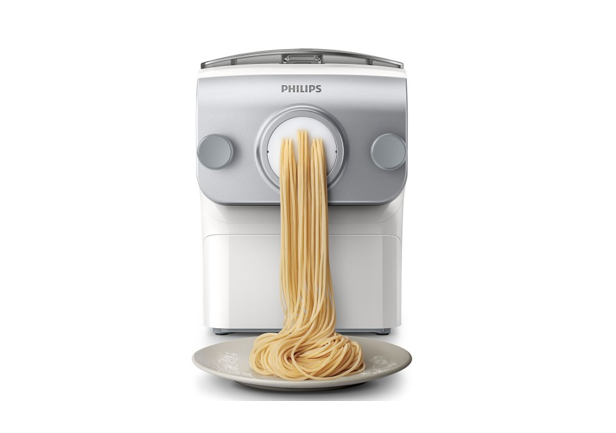Technical Specifications
- AccessoriesIncludedo Cleaning toolo Measuring cupo Recipe booklet
- General specificationsNumber of shaping mouths 8Prefix programs 2Product featureso Dishwasher safeo LED displayo On/off switcho Ready signalo Storage compartment
- Technical specificationsCord length39.4 inchFrequency60 HzPower150 WVoltage120 V
- Weight and dimensionsDimension of packaging (WxDxH)16.5 x 12.6 x15.2 inchDimensions of product (LxWxH)12.4 x 13.5 x 8.5 inchSlot size (LxWxH)12.4 inchWeight incl. packaging359.8 ozWeight of product243.4 oz
- DesignColorCashmere greyColor of control panelBlack
- FinishingMaterial accessories PlasticMaterial of main body Grey
Troubleshooting
My Philips pasta maker does not work/stopped workingIf your Philips pasta maker doesn’t work, makes alarm sounds or the mixing chamber lid is detached/pushed open, there might be a simple solution.
The pasta maker is overheated due to long and continuous usageIn this case, disconnect your pasta maker from the power source, and allow it to cool down.The chamber lid might not be assembled properlyIf your pasta maker is not working right after pressing the start button, then the chamber lid might not be correctly assembled.Please make sure all the safety pins are fully inserted in their safety switch holes.Depending on your Philips Pasta Maker Model, the safety pins are either one or two pins that need to be in full contact with the switches.
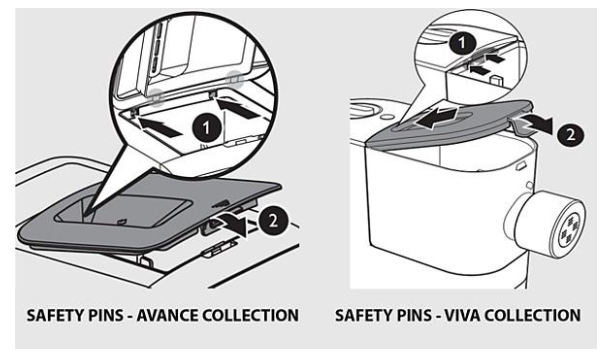
There might be too much flour in the mixing chamberIf you notice the problem while making pasta, then there might be too much flour in the mixing chamber.The maximum amount of flour recommended for each batch of pasta is 400g for Viva (HR237 models) / 500g for Avance (HR235 models).If you have put more than the indicated amount of flour in the mixing chamber, please reduce the amount and make another batch of pasta.
The ratio of flour-water provided in the “Flour/water ratio table” might not have been followed correctlyIn this case, unplug your pasta maker, clean it and restart the pasta making again.If the water flour ratio is correct the dough should have the following consistency: It should be crumbly and appear rather dry. This consistency is needed as with the extrusion forces this is then turned in the perfect pasta dough.
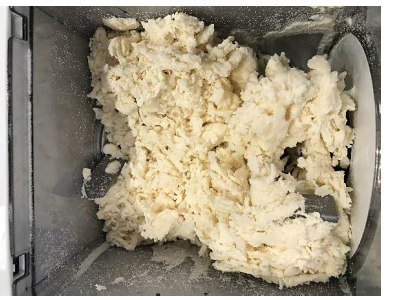
The mixing paddle may be blocked by some foreign objectsPlease make sure there are no foreign objects blocking the mixing paddle.
The wrong program might be selectedUnplug your pasta maker, clean it, and follow the user manual again to restart it.
Not enough/no pasta is coming out of my Philips pasta makerIn the unfortunate event that no pasta coming out, too much leftover dough stays inside or the mixing paddle of your pasta maker is running idle, please find here how to solve it.The flour/water ratio might be incorrectCheck the flour/water ratio: There might be differences regarding flour from country to country. If you are using whole-wheat flour, add another 5ml of liquid.When the water flour ratio is correct, the consistency of the dough should be crumbly and appear rather dry. This consistency is needed in order for the extrusion forces to turn the dough in the perfect pasta dough.Please see the right dough consistency in the following image:

Too much water was used
If you used too much water, disconnect the plug from the power source and discard dough; clean the pasta maker and follow the user manual to restart the pasta-making process.If the dough looks like this, you added too much water:
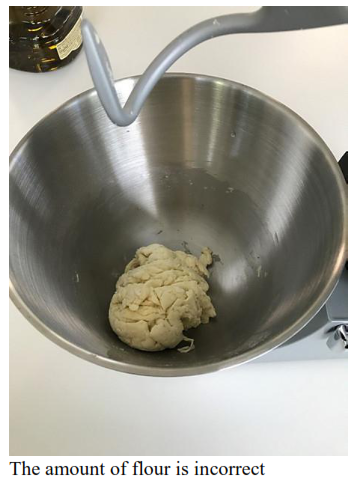
Make sure you are following the recipe by using a kitchen scale or supplied flour cup.The liquid was poured too fastPour liquid slowly into the device for best results. Some dough is left inside the chamberIf only some dough remains inside your pasta maker’s mixing chamber, please put it directly on the mixing paddle with a kitchen tool and start the extrusion-only program.In order to use this program, you need to press the extrusion-only button, and press the start/pause for extra extrusion. The program will take 3 minutes to be completed.The pasta from my Philips pasta maker breaks easily If your Philips pasta maker’s pasta breaks easily, do not worry: just follow these tips and tricks.
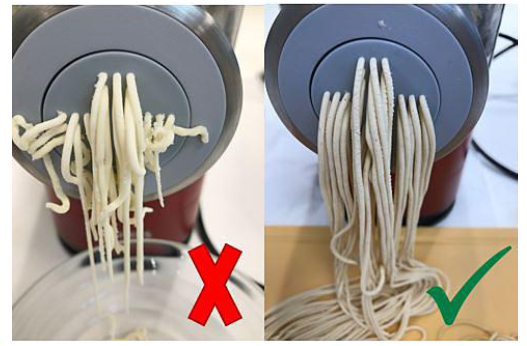
The flour/water ratio might be incorrectIf the flour/water ratio used is not the recommended one, your pasta might break.To solve this, unplug your pasta maker from the power source and discard the dough.Then clean the pasta maker and follow these instructions to restart the pasta making process(please refer to the chapter “Using the pasta maker” in the user manual for more detailed steps):1- Prepare the ingredients.2- Remove the chamber lid.3- Pour the flour in the chamber.4- Close the chamber lid properly.5- Use the “Pasta-making recipe table” and measure the required amount of water.
If the water flour ratio is correct the dough should have the following consistency:It should be crumbly and appear rather dry. This consistency is needed as with the extrusion forces this is then turned in the perfect pasta dough.Note:*Use the supplied flour cup and be aware that it is not a standard 8 oz. measuring cup and should not be used as such .*You can use a kitchen scale to measure the flour weight more accurately.Your dough should look like this:

The wrong type of flour was usedFor ideal results use all-purpose flour or flour with higher protein content (for more information, please refer to the chapter ‘Using the Pasta Maker’ in the user manual or the supplied recipe book).Note:*Use the supplied flour cup and be aware that it is not a standard 8 oz. measuring cup and should not be used as such.*You can use a kitchen scale to measure the flour weight more accurately.
[xyz-ips snippet=”download-snippet”]

